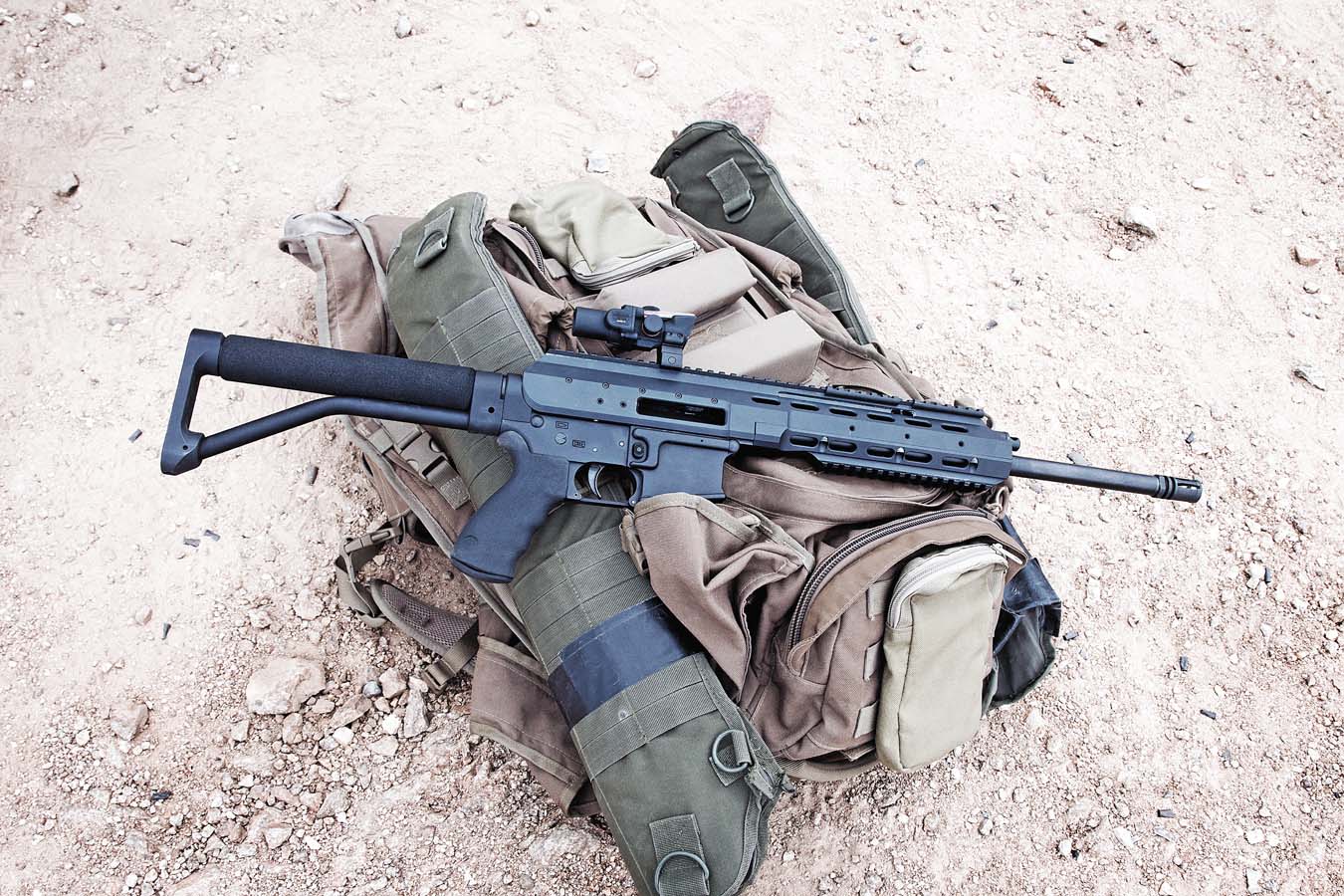[Editor’s Note] We’re delving deep into our back catalog in this column, revisiting designs that first surfaced over a decade ago to see what’s become of them. In this instance, Faxon Firearms has evolved from a one-trick pony to one of the biggest barrel makers in the business, as well as making their own Glock clones and Remington 700 pattern bolt guns.
We asked Bob Faxon if there were any plans to resurrect the Arak 21 and his reply was in the affirmative, following restructuring the defense side of the company. “That is one of my first goals as back in the business,” he said in a recent conversation. We look forward to seeing the revised version.
FAXON ARAK21
What does the Mars Rover have in common with a piston-driven AR? Read on and find out …
Despite their recent surge in popularity, piston-driven ARs have been around for a long time. Colt was the first company to try solving the drawbacks of the original direct impingement (DI) operating system, way back in the decade that good taste forgot.
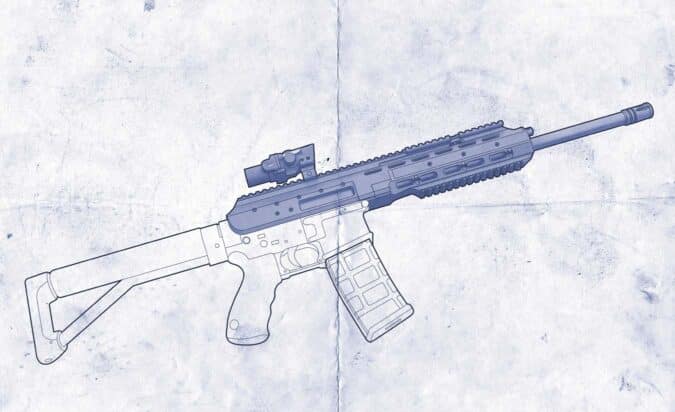
Since the ’70s, numerous others have jumped on the bandwagon, with most of them riffing on Colt’s theme of a short-stroke piston acting on a modified AR bolt carrier. Due to design constraints imposed by the DI upper receiver, all of them swap the old problems of heat and carbon buildup for the new issue of carrier tilt, with some manufacturers addressing it more effectively than others.
Solving hard engineering problems is what Bob Faxon does for a living. Faxon’s company developed the parachute system for the recent Mars Rover, so you could say he has some experience in building gear that works when there’s no chance for a do-over. Bob’s also a shooter and it was only natural for him to found Faxon Firearms.
When he looked at existing piston AR designs, he figured there had to be a better mousetrap. The biggest problem any AR piston gun has is caused by trying to cram a different operating system into the original upper receiver, so this was the first thing to be ditched. Once freed from its constraints, Faxon was able to design an upper that incorporates hardened, full-length rails for the carrier to ride on, completely eliminating the problem of carrier tilt.
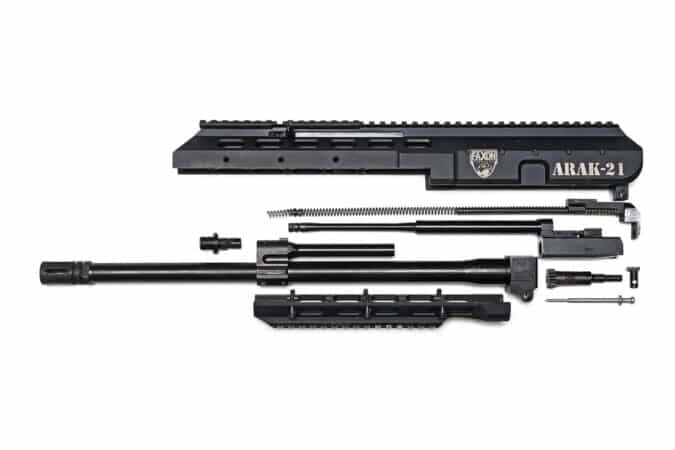
The new receiver design also had enough room inside it to accommodate a recoil spring, removing the need for the AR’s buffer tube and making a folding stock possible.
We tested the first preproduction prototype to be let out of the Faxon shop, and there’s a lot of innovation and hard work gone into this design, so let’s examine it from front to back.
The muzzle device is an A2 flash hider with standard threads, so a screw-on suppressor will fit without modification. Two barrel profiles are due to be offered: a fairly hefty medium contour and a lightweight pencil barrel, both in 16-, 18- and 20-inch lengths.
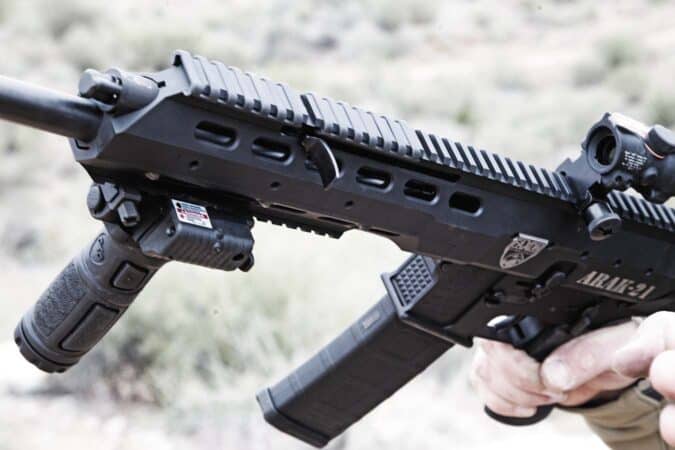
The 5.56-caliber barrels will feature a 1:7 twist and the 300 BLK will utilize a 1:8, so that the widest range of bullet weights can be used and so the user can practice with lower-cost ammo before, say, heading out to slay hogs with the more expensive chambering. Both barrels are made in-house from 4145 pre-hardened chrome-moly steel and there are plans to nitride the production versions (along with the bolt and carrier) to increase their life span.
An adjustable gas block is permanently installed 9 inches from the chamber and has settings for normal and suppressed operation. Because this is a piston gun, the benefits of a free-floated barrel can’t be fully realized, so the Faxon team took the approach of keying the gas block into slots cut into the monolithic upper.
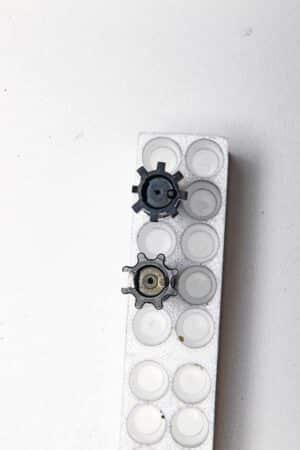
The theory is that this approach stabilizes everything to the rear of the gas block and adds rigidity to both the barrel and handguards, but because the key slots allow for independent expansion as everything heats up, point-of-impact shift is minimized.
We did notice some vertical stringing on the range when using 77-grain bullets in the 5.56 upper, but 55-grain bullets all shot into a circular group. Accuracy was about average for a piston gun and with this sample we could count on five-shot, 2-inch groups at 100 yards all day long with ammo that it liked, with some cloverleaves thrown in for good measure.
TAKE CHARGE
Riding in a slot cut in either side of the handguard is a forward-mounted charging handle, which can be switched for either right- or left-handed use. Unlike the one used by the SCAR, the Faxon’s is non-reciprocating.
This is a big improvement in ergonomics over the AR’s charging handle location, which was barely OK when originally designed in the iron-sight era, but (let’s face it) sucks when using optics. In the event of a stoppage, the user barely has to shift the support hand grip in order to rack the charging handle and get the gun back into action. The upper receiver features a one-piece top rail for optics mounting (rail height is approximately ½-inch taller than a typical AR).
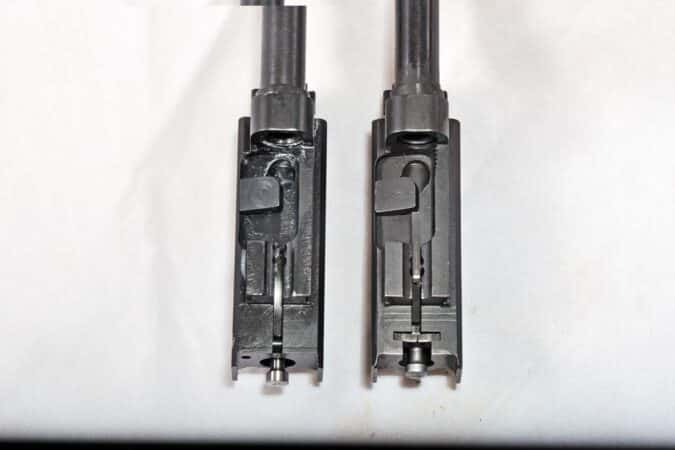
The barrel is retained by a lower handguard that attaches via six captive screws, which thread into steel inserts rather than relying on just the aluminum upper for strength.
A long-known weakness of the AR platform is its bolt, which has sharp corners at the base of each of lug, producing stress risers that eventually cause the lugs to shear. One way to prevent this is by turning those sharp corners into a gentler radius, spreading the forces out instead of concentrating them. Rather than using a typical AR bolt, the ARAK’s bolt and the matching barrel extension feature lugs that are radiused over their entire length, producing a design that the manufacturer claims is 30-percent stronger.
The ARAK bolt also increases the number of lugs from seven to eight, though the pair that straddles the extractor is shaved down a little. The bolt lugs most susceptible to shearing in the AR-15 platform are the ones closest to the extractor, as they take much more stress than the others due to asymmetrical spacing around the bolt head. The ARAK’s bolt lugs are more evenly spaced, as well as being closer together, and hence, more equally stressed.
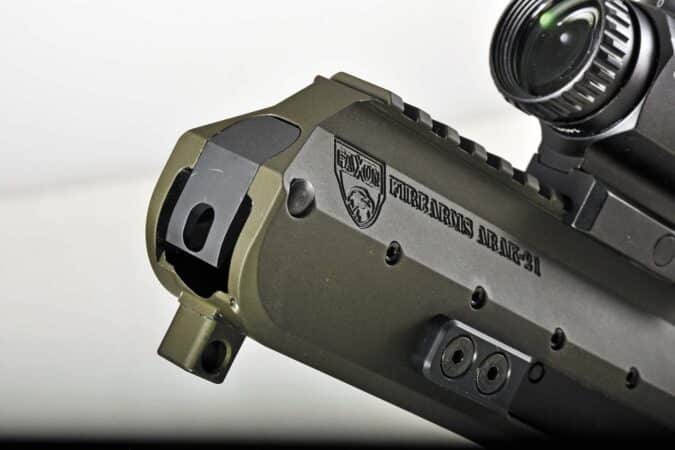
About the only criticism that can be leveled at this arrangement is that the extractor’s bearing surface is reduced versus that of a normal AR. Having ripped extractors through a fair number of case rims in our time, we reserve judgment on this design until we’ve been able to put several thousand rounds through the upper. (Note: We were recently shown samples of a revised bolt head that featured a wider extractor, but did not have one on hand for this test).
CARRIED AWAY
The heart of the Faxon system is its carrier, which is a work of industrial art. Comprised of two main sub-assemblies, namely the piston and the carrier itself, it serves as a sleeve for the recoil spring, much like an AK-47, while housing the very AR-like bolt. Disassembly couldn’t be easier. Press down on the lever between the guide rails, tip out the standard AR firing pin, lift the cam pin, and pull the bolt out of the front.
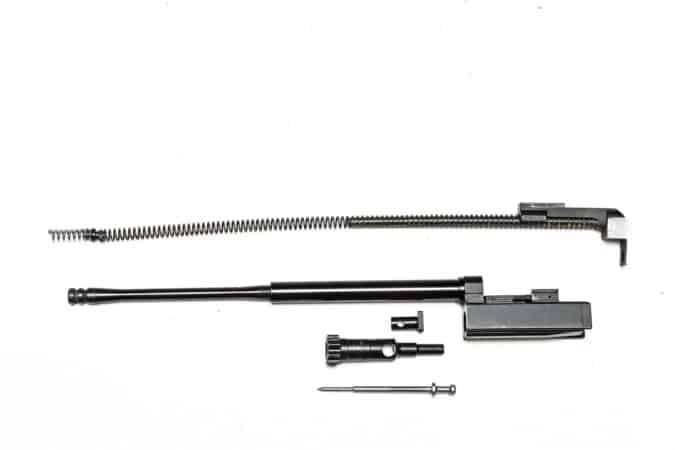
There’s no cotter pin to lose. Faxon plans on offering the upper in both a right- and left-handed version, and, because of this, it’s possible to reassemble the bolt with the head oriented 180 degrees out of position. I did not do this, nosiree …
The system’s recoil spring is well thought out. With the outside diameter enclosed by the piston and a guide rod running up the center, there’s no possibility of kinking and service life is probably measured in decades. The last inch of spring is made from a heavier gauge wire, which cushions the carrier’s final few thousandths of travel and reduces felt recoil. The whole system bottoms out on the guide rod, which means the spring always has air between its coils and is never overstressed.
PERFORMANCE EVALUATION
We got the opportunity to run the gun hard (not just put a few rounds through it at a press event), and as is the case with all prototypes, there are a few things that we would change. Firstly, it’s possible to tie the gun up if you press in the takedown plate in the rear of the upper receiver when everything is assembled.
When this happens, the user has to pivot the receivers apart and reset the plate back to its working position, which is decidedly sub-optimal. We’ve learned that a modification will be added to the plate to prevent this from happening in production uppers, so this should hopefully be a non-issue.
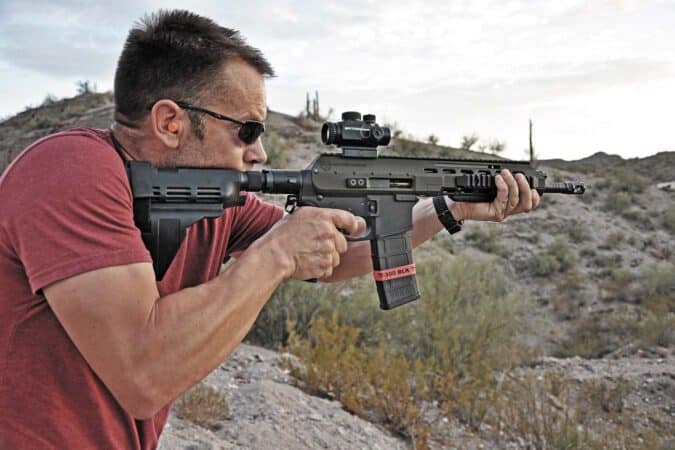
Markings for the gas settings should be engraved on both the gas block and plug, and these should preferably be tactile also. The biggest issue from a usability standpoint, though, relates to the monolithic upper and its relationship to the gas block. By tying the two together, heat is transferred to the handguards.
After dumping a SureFire 60-round mag, this area gets hot. Like, swearingly hot. By adding side rails and KAC covers, or by running the gun using a VFG, this can be overcome, but for now it’s a problem. Finally, our prototype was tattooed on its left flank with only slightly fewer graphics than a NASCAR starting grid. Not a fan.
Overall, we think that this is a very promising design and would like to see it in a couple of other options. The 6.5 Grendel has always run on the very edge of the AR’s performance envelope, and the Faxon bolt seems to offer a worthwhile upgrade in terms of strength. The lack of a buffer tube would lend itself to a very slick, folding stocked, 10-inch barrel PDW variant, particularly in 6.8 SPC, as that cartridge really shines in short barrels.
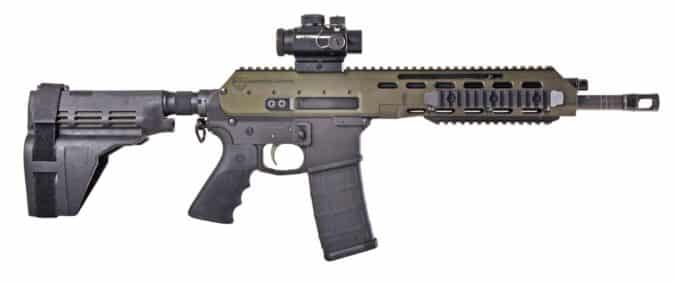
By offering a high-quality piston upper with both 5.56 and 300BLK barrels for $1,459, we predict these will sell like ice cream on a summer day, especially among suppressor owners or those looking for a bit more downrange performance than the NATO cartridge offers, and we look forward to seeing how the design matures.
For now, we’ll be holding onto this one and trying our best to break it over the next few months. Check back for updates.
Read the full article here




